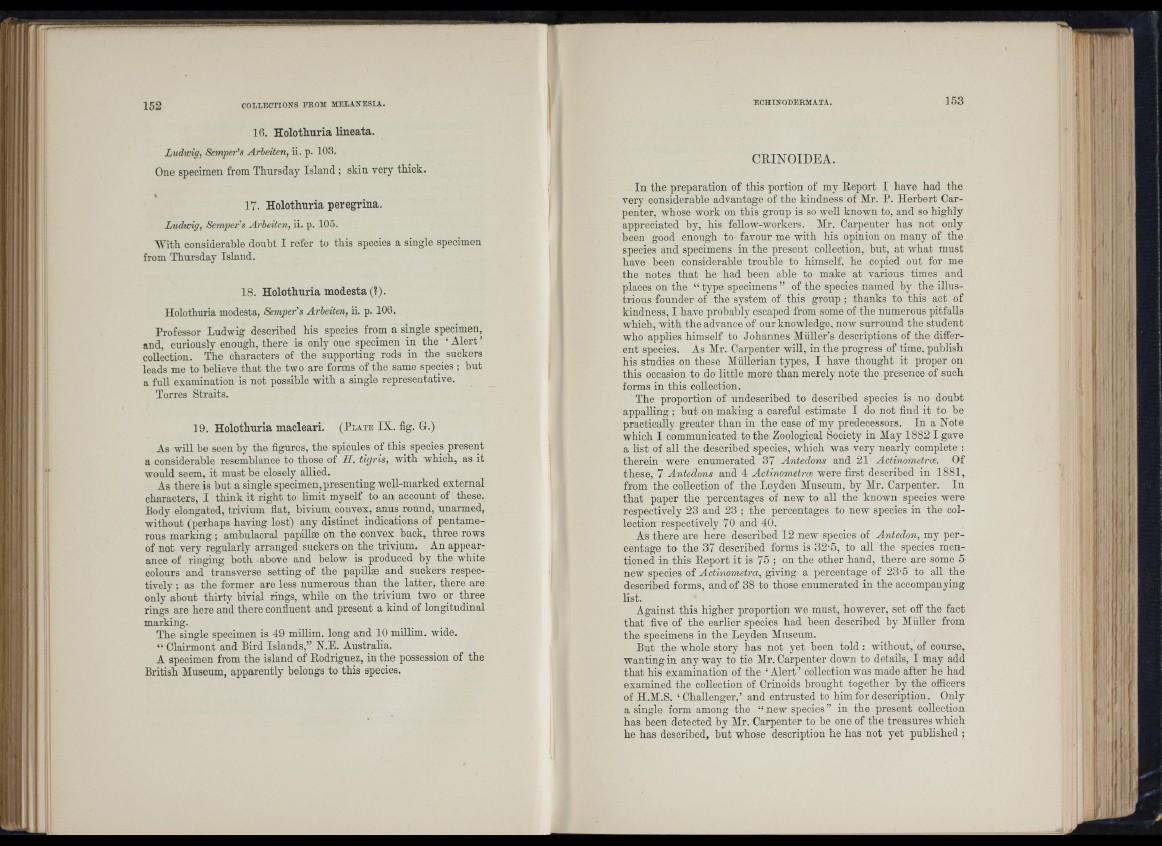
H' t1
ì í
H
l i
16. Holotlmria lineata.
Ludioig, Semper’s Arbeiten, ii. p. 103.
One specimen from Thursday Island ; skin very thick.
■ ! < ?
17. Holothuria peregrina.
Ludwig, Sempers Arbeiten, ii. p. 105.
AVith considerable doubt I refer to this species a single specimen
from Thursday Island.
18. Holothuria modesta (?).
Holothuria modesta, Semper's Arbeiten, ii. p. 106.
Professor Ludwig described his species from a single specimen,
and, curiously enough, there is only one specimen in the ‘ A le rt’
collection. The characters of the supporting rods in the suckers
leads me to believe th at the two are forms of the same species ; but
a full examination is not possible with a single representative.
Torres Straits.
19. Holothuria macleari. (P late IX. fig. G.)
As will be seen by the figures, the spicules of this species present
a considerable resemblance to those of H. tigris, with which, as it
would seem, it must be closely allied.
As there is but a single specimen,presenting well-marked external
characters, I think it right to limit myself to an account of these.
Body elongated, trivium fiat, bivium convex, anus round, unarmed,
without (perhaps having lost) any distinct indications of pentame-
rous marking ; amhulacral papillæ on the convex hack, three rows
of not very regularly arranged suckers on the trivium. An appearance
of ringing both above and below is produced by the white
colours and transverse setting of the papillæ and suckers respectively
; as the former are less numerous than the latter, there are
only about thirty bivial rings, while on the trivium two or three
rings are here and there confinent and present a kind of longitudinal
marking.
The single specimen is 49 millim. long and 10 millim. wide.
“ Clairmont and Bird Islands,” N.E. Australia.
A specimen from the island of Eodriguez, in the possession of the
British Museum, apparently belongs to this species.
I n
CRINOIDEA.
In the preparation of this portion of my Eeport I have had the
very considerable advantage of the kindness of Mr. P. Herbert Carpenter,
whose work on this group is so well known to, and so highly
appreciated by, his fellow-workers. Mr. Carpenter has not only
been good enough to favour me with his opinion on many of the
species and specimens in the present collection, but, at what must
have been considerable trouble to himself, he copied out for me
the notes that he had been able to make at various times and
places on the “ type specimens” of the species named by the illustrious
founder of the system of this group ; thanks to this act of
kindness, I have probably escaped from some of the numerous pitfalls
which, with the advance of our knowledge, now surround the student
who applies himself to Johannes Miiller’s descriptions of the different
species. As Mr. Carpenter will, in the progress of time, publish
his studies on these Müllerian types, I have thought it proper on
this occasion to do little more than merely note the presence of such
forms in this collection.
The proportion of nndescribed to described species is no doubt
appalling ; but on making a careful estimate I do not find it to be
practicaÛy greater than in the case of my predecessors. In a Note
which I communicated to the Zoological Society in May 1882 I gave
a list of all the described species, which was very nearly complete :
therein were enumerated 37 Antedons and 21 Actinometrce. Of
these, 7 Antedons and 4 Actinometrce were first described in 1881,
from the collection of the Leyden Museum, by Mr. Carpenter. In
th at paper the percentages of new to all the known species were
respectively 23 and 23 ; the percentages to new species in the collection
respectively 70 and 40.
As there are here described 12 new species of Antedon, my percentage
to the 37 described forms is 32-5, to all the species mentioned
in this Eeport it is 75 ; on the other hand, there are some 5
new species of Actinometra, giving a percentage of 23-5 to all the
described forms, and of 38 to those enumerated in the accompanying
list.A
gainst this higher proportion we must, however, set off the fact
th at five of the earlier species had been described by MiiUer from
the specimens in the Leyden Museum.
But the whole story has not yet been told : without, of course,
wanting in any way to tie Mr. Carpenter down to details, I may add
th at his examination of the ‘ Alert ’ collection was made after he had
examined the collection of Crinoids brought together by the officers
of H.M.S. ‘ Challenger,’ and entrusted to him for description. Only
a single form among the “ new species ” in the present collection
has been detected by Mr. Carpenter to be one of the treasures which
he has described, hut whose description he has not yet published ;
Í ii